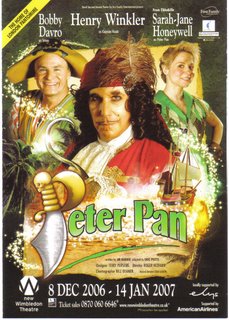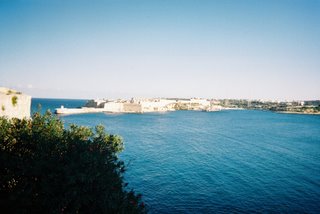Are you Sure it's Peter Pan?
One of the many traditions that thrive in Britain (and one that seems to be unique to Britain and, perhaps, closely associated countries) is pantomime. These are theatrical productions that are put on at venues all over the country, primarily during the Chrismas season. They aren't plays or musicals in the correct sense of those descriptions; they aren't dance or opera productions; they aren't comedy shows or theatre for children. But they seem to be a combination of all of these genres.
The below is quoted from http://www.lazybeescripts.co.uk/Panto.htm:
"Pantomime is a curious entertainment - a form of ritual theatre staged around the winter solstice. Originally silent (a form of mime), it is now anything but, with extensive vocalisation from both the performers and the audience.
The stories are generally well-known (drawn from popular folk-tales and similar sources), populated with stock characters, including a principal boy, generally played by a young lady with shapely legs, the heroine, also played by a young lady (which gives an added edge to the inevitable romance) and a dame, played by a man as an exaggeration of a lewd middle-aged lady. Scripts change from year to year, but generally contain four strands of humour: visual, topical, corny and downright rude. In the UK this is considered to be family entertainment. "
Some of the popular, and oft re-done and re-written versions of "Panto" include the stories of Aladdin, Cinderella, Peter Pan, Dick Whittington and his cat (a real-life mayor of London in the 16th century -- though the Panto differs a great deal from the real story), Jack and the Beanstalk, Snow White and others.
Kathi had seen Dick Whittington when we lived in England in 2000/2001 -- she went with the kids from the school where she was a volunteer at the time. More recently she went with two other ladies (one visiting from the US) to see Cinderella just last week. For some time she's been reminding Chuck that he should not miss the experience and the two of us went yesterday, December 9th, to see Peter Pan in the London suburb of Wimbledon (where the All England Lawn Tennis Club is located). We chose this particular show, from among the dozen or more being staged in the London area, because it starred Henry Winkler -- the "Fonz" from the "Happy Days" TV show.
The audience, of course, is made up of large numbers of kids, (who, of course, show their appreciation for the antics by screaming at very high decibel levels) with parents or aunts and uncles or grandparents. Did I say there are a lot of kids there? They tend to be a little noisy. Did I mention that?
Invariably, during the performance, some of the characters begin to engage the audience in dialog. The audience roundly boos the villain whenever he appears -- and cheers the hero. If the villain is hiding a weapon, or setting a trap, the audience loudly advises the hero ("he's behind the tree"). To give you a bit of an idea of how "flexible" the format is, this one even included the characters singing the "Happy Days" theme song, as though it were part of the story of Peter Pan.
It was actually a lot of fun to watch the kids have such a good time. (Did I mention that they tend to be a little bit on the noisy side?) Pantomime won't, however, replace our frequent visits to the West End theatres of London. (By the way, Henry Winkler wasn't nearly as good as the much lesser-known Brits playing the other parts.)
The below is quoted from http://www.lazybeescripts.co.uk/Panto.htm:
"Pantomime is a curious entertainment - a form of ritual theatre staged around the winter solstice. Originally silent (a form of mime), it is now anything but, with extensive vocalisation from both the performers and the audience.
The stories are generally well-known (drawn from popular folk-tales and similar sources), populated with stock characters, including a principal boy, generally played by a young lady with shapely legs, the heroine, also played by a young lady (which gives an added edge to the inevitable romance) and a dame, played by a man as an exaggeration of a lewd middle-aged lady. Scripts change from year to year, but generally contain four strands of humour: visual, topical, corny and downright rude. In the UK this is considered to be family entertainment. "
Some of the popular, and oft re-done and re-written versions of "Panto" include the stories of Aladdin, Cinderella, Peter Pan, Dick Whittington and his cat (a real-life mayor of London in the 16th century -- though the Panto differs a great deal from the real story), Jack and the Beanstalk, Snow White and others.
Kathi had seen Dick Whittington when we lived in England in 2000/2001 -- she went with the kids from the school where she was a volunteer at the time. More recently she went with two other ladies (one visiting from the US) to see Cinderella just last week. For some time she's been reminding Chuck that he should not miss the experience and the two of us went yesterday, December 9th, to see Peter Pan in the London suburb of Wimbledon (where the All England Lawn Tennis Club is located). We chose this particular show, from among the dozen or more being staged in the London area, because it starred Henry Winkler -- the "Fonz" from the "Happy Days" TV show.
The audience, of course, is made up of large numbers of kids, (who, of course, show their appreciation for the antics by screaming at very high decibel levels) with parents or aunts and uncles or grandparents. Did I say there are a lot of kids there? They tend to be a little noisy. Did I mention that?

Invariably, during the performance, some of the characters begin to engage the audience in dialog. The audience roundly boos the villain whenever he appears -- and cheers the hero. If the villain is hiding a weapon, or setting a trap, the audience loudly advises the hero ("he's behind the tree"). To give you a bit of an idea of how "flexible" the format is, this one even included the characters singing the "Happy Days" theme song, as though it were part of the story of Peter Pan.
It was actually a lot of fun to watch the kids have such a good time. (Did I mention that they tend to be a little bit on the noisy side?) Pantomime won't, however, replace our frequent visits to the West End theatres of London. (By the way, Henry Winkler wasn't nearly as good as the much lesser-known Brits playing the other parts.)

